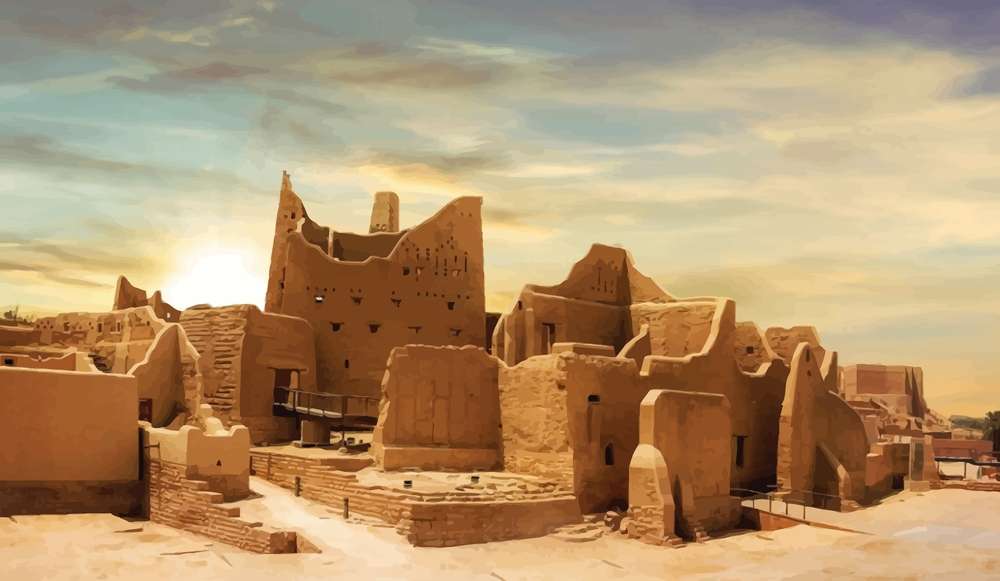
Saudi Arabia
Land of old customs and vivid culture, Saudi Arabia also serves as a melting pot of global gastronomic inspirations. The country’s location at the junction of trade routes and its past ties to several civilizations have molded a rich gastronomic legacy. From the busy souks to contemporary restaurants, Saudi Arabia’s flavors create a mouthwatering tapestry of worldwide influence that is deftly incorporated into classic Saudi cuisine.
A Culinary Crossroads of History
The gastronomic variety of the Kingdom has been significantly shaped by its position along ancient trading routes. Saudi cuisine has been permanently changed by spices, grains, and foods introduced by traders and visitors from India, Persia, Africa, and the Mediterranean. Traditionally introduced centuries ago, flavors and techniques in dishes like kabsa and jareesh mix themselves with local ingredients to produce famous dinners. The worldwide influences seen in Saudi kitchens are shown in this mix of imported spices such as saffron, cinnamon, and cardamom with locally cultivated foods, including dates and lamb.
SAUDI VISA FOR UK RESIDENTS FOR 90 DAYS
The Indian and South Asian Influence
Indian and South Asian cooking traditions have dramatically shaped Saudi Arabia’s gastronomic scene. Cooking methods and tastes have come from the long-standing trade between the Arabian Peninsula and the Indian subcontinent. Many Saudi foods highlight the pungent tastes and aromatic spices typical of South Asian cuisine. For instance, the renowned Saudi rice dish mandi comes from similar biryani-style cooking in India and Pakistan. Saudi cuisine emphasizes this close relationship by including turmeric, cumin, and coriander.
Persian Delights in Saudi Fare
Furthermore, Persian cuisine is essential in forming Saudi Arabia’s gastronomic character. A dish like maharishi (stuffed veggies) and hares (a slow-cooked wheat and meat porridge) clearly show shared culinary traditions, including dried fruits, nuts, and saffron. Persian kebabs and stews have shaped how meat is cooked and flavored in Saudi homes, sometimes producing tender, aromatic meals that mirror a harmonic mix of cultures.
Mediterranean and Levantine Contributions
Saudi cooking has been permanently influenced by Mediterranean and Levantine flavors. Standard favorites in Saudi homes and restaurants include hummus, falafel, and tabbouleh. Extensive use of olive oil, pomegranates, and fresh herbs like parsley and mint stems directly from Mediterranean cooking techniques. These tastes provide a cool counterpoint to the richness of traditional Saudi cuisine, producing substantial and healthy meals.
African Influences in Saudi Cuisine
The historical and cultural links between Saudi Arabia and Africa have also shaped the gastronomy of the Kingdom. From the southern provinces to the coast of the Red Sea, African influences abound in the use of sorghum, millet, and spices like fenugreek. Stuffed savory pastry like murabba is thought to have come from African and Yemeni cooking. These ties highlight how perfectly African tastes fit Saudi cooking methods.
Modern Global Flavors in Saudi Arabia
Saudi Arabia’s gastronomic scene has lately welcomed even more worldwide inspiration. The range of food accessible has increased with the arrival of foreign cuisines via expatriates and worldwide dining patterns. From American burgers to Italian spaghetti and Japanese sushi, the new Saudi dining scene honors world cuisine. These worldwide trends are now combined with traditional Saudi tastes by several chefs and restaurants in the Kingdom to produce creative and distinctive meals appealing to a broad customer base.
Conserving Custom While Accepting the World
Saudi Arabia has maintained its gastronomic legacy in the face of world influences. Like they were decades past, traditional foods like kappa, murabba, and samosa are made with the same care and respect. Concurrent with this, the chefs and foodies of the Kingdom are discovering ways to honor the core of Saudi cuisine while including foreign tastes. This harmony of history and modernism guarantees that the gastronomic character of the nation will always flourish in a world becoming more global.
Conclusion: A Culinary Journey Worth Savoring
Investigating Saudi Arabia’s gastronomic scene is like setting off a taste adventure across continents and history. Every meal recounts trade, cross-cultural interaction, and shared customs spanning centuries and countries. Whether it’s the spiced smells of Indian-inspired rice dishes, the sweetness of Persian-infused desserts, or the tart freshness of Mediterranean salads, the worldwide influences in Saudi cuisine make it a real treat for foodies. The cuisine of the Kingdom will indeed remain evidence of its rich legacy and openness to the globe as it develops.
Also read: Why Saudi Arabia’s Traditional Markets Are a Shopper’s Delight



